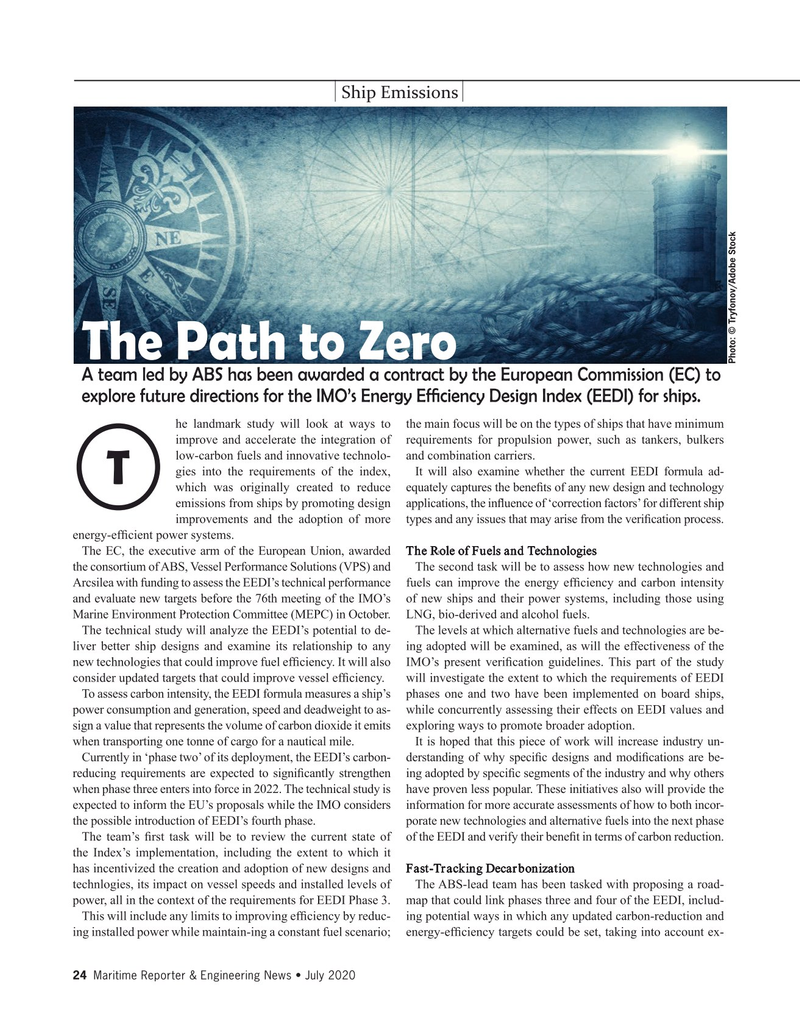
Page 24: of Maritime Reporter Magazine (July 2020)
Maritime Power Edition
Read this page in Pdf, Flash or Html5 edition of July 2020 Maritime Reporter Magazine
Ship Emissions
The Path to Zero
Photo: © Tryfonov/Adobe Stock
A team led by ABS has been awarded a contract by the European Commission (EC) to explore future directions for the IMO’s Energy Effciency Design Index (EEDI) for ships.
he landmark study will look at ways to the main focus will be on the types of ships that have minimum improve and accelerate the integration of requirements for propulsion power, such as tankers, bulkers low-carbon fuels and innovative technolo- and combination carriers. gies into the requirements of the index, It will also examine whether the current EEDI formula ad-
T which was originally created to reduce equately captures the benefts of any new design and technology emissions from ships by promoting design applications, the infuence of ‘correction factors’ for different ship improvements and the adoption of more types and any issues that may arise from the verifcation process. energy-effcient power systems.
The EC, the executive arm of the European Union, awarded The Role of Fuels and Technologies the consortium of ABS, Vessel Performance Solutions (VPS) and The second task will be to assess how new technologies and
Arcsilea with funding to assess the EEDI’s technical performance fuels can improve the energy effciency and carbon intensity and evaluate new targets before the 76th meeting of the IMO’s of new ships and their power systems, including those using
Marine Environment Protection Committee (MEPC) in October. LNG, bio-derived and alcohol fuels.
The technical study will analyze the EEDI’s potential to de- The levels at which alternative fuels and technologies are be- liver better ship designs and examine its relationship to any ing adopted will be examined, as will the effectiveness of the new technologies that could improve fuel effciency. It will also IMO’s present verifcation guidelines. This part of the study consider updated targets that could improve vessel effciency. will investigate the extent to which the requirements of EEDI
To assess carbon intensity, the EEDI formula measures a ship’s phases one and two have been implemented on board ships, power consumption and generation, speed and deadweight to as- while concurrently assessing their effects on EEDI values and sign a value that represents the volume of carbon dioxide it emits exploring ways to promote broader adoption.
when transporting one tonne of cargo for a nautical mile. It is hoped that this piece of work will increase industry un-
Currently in ‘phase two’ of its deployment, the EEDI’s carbon- derstanding of why specifc designs and modifcations are be- reducing requirements are expected to signifcantly strengthen ing adopted by specifc segments of the industry and why others when phase three enters into force in 2022. The technical study is have proven less popular. These initiatives also will provide the expected to inform the EU’s proposals while the IMO considers information for more accurate assessments of how to both incor- the possible introduction of EEDI’s fourth phase. porate new technologies and alternative fuels into the next phase
The team’s frst task will be to review the current state of of the EEDI and verify their beneft in terms of carbon reduction.
the Index’s implementation, including the extent to which it has incentivized the creation and adoption of new designs and Fast-Tracking Decarbonization technlogies, its impact on vessel speeds and installed levels of The ABS-lead team has been tasked with proposing a road- power, all in the context of the requirements for EEDI Phase 3. map that could link phases three and four of the EEDI, includ-
This will include any limits to improving effciency by reduc- ing potential ways in which any updated carbon-reduction and ing installed power while maintain-ing a constant fuel scenario; energy-effciency targets could be set, taking into account ex- 24 Maritime Reporter & Engineering News • July 2020

 23
23

 25
25
